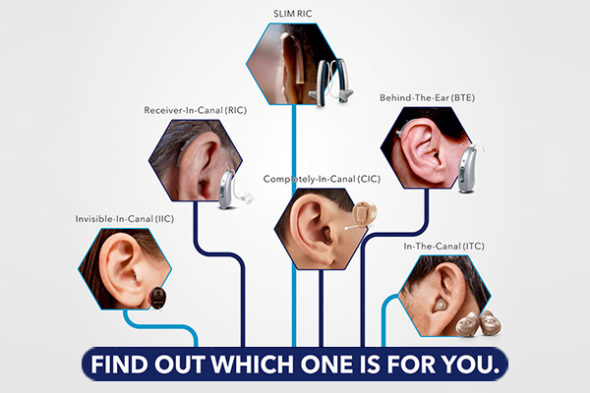
Different Types Of Hearing Aids
What are the different types of hearing aids? What care one must do for their hearing aids?
Before discussing the different types and styles of hearing aids let us get acquainted with basic’s of hearing aid. Hearing loss can cause a big impact on your life right from your relationships at work as well as home. Wearing a hearing aid can make a big difference especially if you pick the right ones and get help in adjusting to them quickly and adopting a change in your lifestyle.
How Can Hearing Aid be of Help to you?
A hearing aid is a battery-powered electronic device designed to improve your hearing. Hearing aids are so small that you wear in or behind your ear, they make some sounds louder. They may help you hear better when it’s quiet and when it’s noisy. A brief about how hearing aids work is as follows;
- A microphone picks up sound around you.
- An amplifier makes the sound louder.
- A receiver amplifies the sounds into your ear
- An audiologists can figure out which kind of hearing aid will work best for you, as well as what special features you need. The right kind of device suited for you depends on the following:
- Your Lifestyle and Profession
- The severity of your hearing loss
- Your age and how well you can manage these small devices
- Hearing aid and the cost
There are two main types of hearing aids
Analog hearing aids convert sound waves into electrical signals and amplifies them. Analog hearing aids are less expensive and have simple volume controls.
Digital hearing aids convert sound waves into numerical codes similar to Computer binary codes and they amplify them. The binary codes include information such as the direction of a sound, its pitch or volume.
That makes it easier to adjust the sound to what you need in different situations like if you’re in a restaurant, a quiet room, or a stadium. Most of the time it will adjust automatically. These types of hearing aid cost more than an analog hearing aid, the results are much better, though they are smaller but more powerful.
There are 3 main styles of hearing aids. They usually differ in size, placement inside or on the ear, and how well they make sound louder
Invisible-In-The-Canal (IIC)
The IIC custom-fitted hearing aid is inserted farther into the canal and it is completely invisible when worn. This IIC type of hearing aids is designed to be removed daily to promote good ear health.
The invisible-in-canal (IIC) hearing aid is nearly impossible for others to see. You can either wear it or remove it every day or may wear it for several months at a time. These type of hearing aids are used for mild to moderate hearing loss cases.
Completely-In-Canal (CIC)
CIC hearing aids are custom-made to fit completely in the ear canal and only the tip of a small plastic “handle” is seen outside the canal, which is used to insert and remove the instrument.
A completely-in-canal (CIC) hearing aid is small and completely hidden inside your ear. Being small in size they can be hard to adjust and remove every time. CIC type of hearing aid is not suited for children or adults who might have problems with very small devices. This type of hearing aid is usually helping in mild to moderate and severe hearing loss cases.
In-The-Canal (ITC)
The Canal hearing aids are fitted inside your ear and cannot be seen by anyone. The ITC hearing aid fits your specific ear canal and are made custom-fit in the ear canal with a smaller portion of the hearing aid showing in the outer ear. It’s best suited for mild to severe hearing loss.
In-The-Ear (ITE)
ITE hearing aids are made custom-fit within the outer portion of the ear. They have a hard-plastic case that holds the electronics. These type of hearing aid are best for people with mild to severe hearing loss, but usually, don’t work as well for children whose ears are still growing.
Receiver-In-Canal (RIC)
The RIC is barely visible when worn. In this type of hearing aid, the receiver, or speaker, is inside the ear canal. These allow low-frequency sounds to enter the ear naturally and high-frequency sounds are amplified through the hearing aid. RIC hearing aids provide a comfortable, open-fit for mild to profound hearing loss.
Behind-The-Ear (BTE)
Behind-the-ear (BTE) hearing aids are housed in a firm plastic case behind your ear. A plastic ear mold fits inside the outer ear and directs sound to the ear. The other type of hearing aid usually called Mini BTE fits entirely behind your ear along with a narrow tube that goes into your ear canal. Due to this earwax does not build up and makes sure your own voice sound is clear. BTEs usually works for mild to severe hearing loss
Caring for Your Hearing Aid
- The hearing aids last much longer if you take good care of them. Some advice to keep in mind;
- Avoid exposure to heat, moisture, hair care products, children, and pets.
- Clean them as directed by the audiologist/ hearing aid company
- Turn off your hearing device when not in use.
- Always replace dead batteries immediately.
- Hearing aid batteries last for several days to a couple of weeks. Battery life depends on the battery type, hearing aid power requirements, and how often you are using your hearing aids in a day.